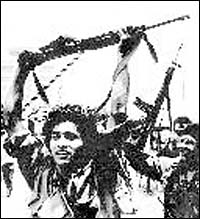 Haiti’s capital Port-au-Prince is bracing itself for an outbreak of cholera as the disease which has killed 200 in the countryside makes itself known in the city. The five confirmed cases in the capital are among more than 2,000 people who were infected in an outbreak mostly centred in the Artibonite region north of Port-au-Prince. At least 208 people have died with that figure likely to rise in the country’s first outbreak of cholera since 1960. The outbreak is the latest disaster to hit the poverty-stricken country still struggling to recover from the devastating 7.0 earthquake which left much of the country in ruins last January. (photo: David Darg)
Haiti’s capital Port-au-Prince is bracing itself for an outbreak of cholera as the disease which has killed 200 in the countryside makes itself known in the city. The five confirmed cases in the capital are among more than 2,000 people who were infected in an outbreak mostly centred in the Artibonite region north of Port-au-Prince. At least 208 people have died with that figure likely to rise in the country’s first outbreak of cholera since 1960. The outbreak is the latest disaster to hit the poverty-stricken country still struggling to recover from the devastating 7.0 earthquake which left much of the country in ruins last January. (photo: David Darg)Medecins San Frontieres sent assessment teams to the Artibonite region including the coastal town of St Marc, 70km north of Port-au-Prince. MSF said St Marc’s hospital was becoming overcrowded and does not have the capacity to handle a cholera epidemic. MSF staff are giving patients an oral rehydration solution to replace fluids lost from diarrhoea and vomiting symptoms of a cholera infection. Patients too sick to drink the ORS are given infusions intravenously. “The most important thing is to isolate the cholera patients there from the rest of the patients, in order to best treat those people who are infected and to prevent further spread of the disease,” the local MSF coordinator said. “This will also enable the hospital to run as normally as possible. We are setting up a separate, isolated cholera treatment centre now."
David Darg, of the US-based Operation Blessing International, drove the two hours from Port-au-Prince to find a “horror scene” at St Marc hospital. Darg said he had to fight his way through the gate through crowds of distressed relatives while others carried dying relatives into the compound. “Some children were screaming and writhing in agony, others were motionless with their eyes rolled back into their heads as doctors and nursing staff searched desperately for a vein to give them an IV,” he said. “The hospital was overwhelmed, apparently caught out suddenly by one of the fastest killers there is.”
Cholera is an acute intestinal infection caused by bacteria carried in human faeces and can be transmitted by water, some foodstuffs and, more rarely, from person to person. The main symptoms are watery diarrhoea and vomiting, which lead to severe dehydration and rapid death if not treated promptly. According to the World Health Organisation, there are an estimated three to five million cholera cases every year causing between 100,000 to 120,000 deaths. The WHO is worried about the emergence of a new and more virulent strain of cholera that now predominates in parts of Africa and Asia, as well as the unpredictable emergence and spread of antibiotic-resistant strains. And because brackish water and estuaries are natural reservoirs of this strain, cholera could increase where there are rising sea levels and increases in water temperatures.
While it is too early to tell what is causing the Haitian outbreak, conditions in the IDP camps remain primitive and conditions were ripe for disease to strike in areas with limited access to clean water. 230,000 people died in the quake. 1.2 million people were displaced as of August 2010 and a further 1.8 million are affected. According to a post-earthquake fact sheet produced by USAID, the majority of IDPs in Artibonite are “residing with host families, straining resources and creating housing space issues for both groups.” It noted deficiencies in disease reporting processes. As well there has been a mass migration of 120,000 people from Artibonite to Port-au-Prince in search of a better life.
So far there has been no reports of cholera in the camps, but if it does a public health crisis could be imminent. "It will be very, very dangerous," Claude Surena, president of the Haitian Medical Association, said. "Port-au-Prince already has more than 2.4 million people, and the way they are living is dangerous enough already. Clearly a lot more needs to be done."













